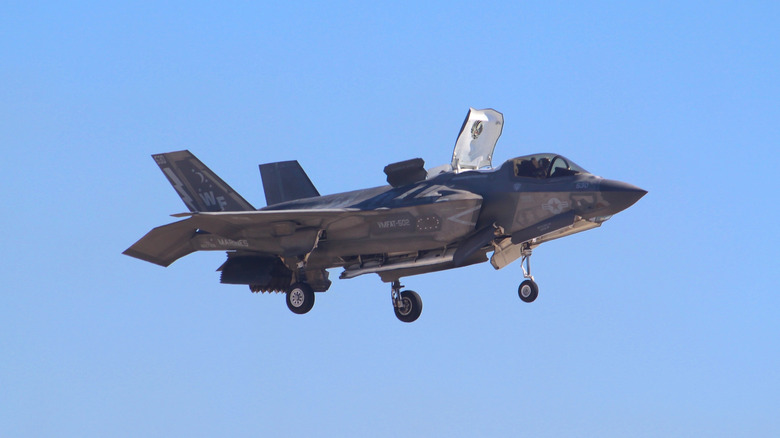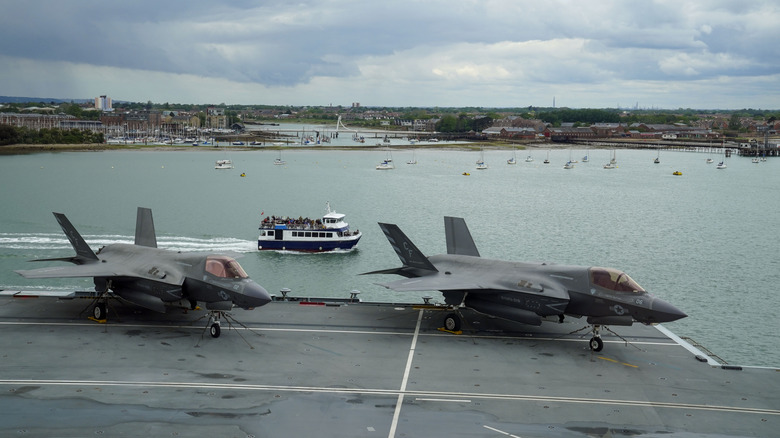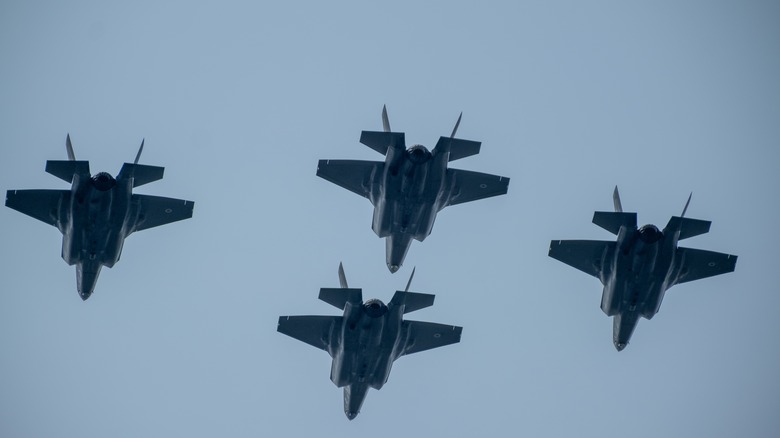How Does The F-35 Lightning II Take Off, And Land Vertically And How Does It Differ From The Harrier?
The F-35 Lightning II is an advanced multirole combat aircraft with enhanced stealth capabilities and a weapons payload that combine to make it one of the most capable fighter jets in the skies today. Manufactured primarily by Lockheed Martin, the F-35 is available in a number of variants, with each one tailored to meet custom operational requirements. The more unique variant, the F-35B Lightning II, is currently the only fifth-generation combat aircraft with short takeoff and vertical landing (STOVL) capabilities.
It's not a new concept for fighter jets. The first operational VTOL aircraft was the Hawker Siddeley Harrier, first developed in the UK in the 1960s. However, both aircraft have different approaches to achieving STOVL. The F-35B has a counter-rotating lift fan hidden under a flap located behind the cockpit. The fan is powered by a drive shaft connected to the aircraft's engine, which also features a swiveling rear-exhaust nozzle. Together, these components generate up to 40,000 pounds of downward thrust, providing enough vertical lift for STOVL operations.
The Harrier fighter jet, on the other hand, relies on a unique thrust vectoring system to generate adequate lift. The AV-8B Harrier II Plus jet, one of the last variants, is built around a Rolls Royce Pegasus engine, the latest of which generates up to 23,800 lbs of thrust. The engine, connected to four rotatable nozzles (located in pairs beneath the wing), diverts the thrust downward, allowing the Harrier to hover, take off vertically, and rapidly transition to horizontal flight. The Harrier jets have been in operational service for several decades and are now set to be replaced by the F-35B Lightning II.
Operational advantages of the F-35B Lightning II
In its standard guise, the F-35 Lightning II is a formidable aerial combat platform. It can simultaneously execute electronic warfare, intelligence gathering, air-to-air, and air-to-surface missions. The F-35B variant, with its STOVL capabilities, pushes that potency to an even higher level.
It can operate from smaller airfields and improvised landing sites, which traditional aircraft cannot. The reduced reliance on conventional runways means F-35B aircraft can be deployed rapidly to respond to threats. It also reduces their vulnerability to enemy attacks as they can be launched from concealed temporary sites.
Due to the lift fan, the F-35B has a smaller internal fuel capacity (and a smaller weapons bay) than other variants. The operational range of the F-35B Lightning II is 900 nautical miles (1,667 km), compared to 1,200 nautical miles (2,222 km) for the F-35A. However, this deficit is offset by the fact that the F-35B can launch from both the smallest and biggest aircraft carriers, greatly extending their operational reach, and allowing them to strike deep into enemy territory.
Who currently operates the F-35B Lightning II?
The F-35B is the first supersonic-capable STVOL design in aviation history. In the U.S., it is operated primarily by the United States Marine Corps. In 2015, the armed service declared the F-35B's initial operational capability (IOC) and recently announced plans to eventually purchase 280 F-35Bs. In 2018, the USMC deployed the F-35B on its first combat mission to strike targets in Afghanistan.
The USMC is not the only customer buying the F-35B Lightning II. Britain's Royal Navy placed an initial order for 48 F-35B jets, of which 37 have already been delivered. The Royal Navy has extensive experience operating STOVL aircraft. This knowledge was gleaned from its fleet of Harrier jets, which it operated for about four decades before they were disbanded in 2010.
The Italian Navy and Air Force are other customers that have ordered the F-35B aircraft. The Defense Post reported that each branch of the country's military force will be getting at least five units of the F-35B Lightning II aircraft.


